© Copyright Atlanta Coin Expositions, 2008-2025. All Rights Reserved.
Several of the links on the pages within this web site go to affiliate vendors.
A vendor affiliation can mean a small monetary compensation to the web site owner at no additional cost to you.
Several of the links on the pages within this web site go to affiliate vendors.
A vendor affiliation can mean a small monetary compensation to the web site owner at no additional cost to you.
Coin Show
Information
Shop
General
Next Monthly Coin Show
Coin Show - Monthly Notes for Virtual April 2020
Unfortunately, the May 3rd Greater Atlanta Coin Show had to be canceled due to the ongoing COVID-19 coronavirus situation in our area.
We will continue to review the circumstances and decide the status of upcoming shows a week or two before each show.
Check for the status of our future monthly coin shows on the web site, in our newsletter and on the recorded phone message for the show.
We will continue to review the circumstances and decide the status of upcoming shows a week or two before each show.
Check for the status of our future monthly coin shows on the web site, in our newsletter and on the recorded phone message for the show.
Sealed Bag 1973 Philadelphia One Cent Coins
Jefferson Five Cent Coin
The April 2020 monthly Greater Atlanta Coin Show wanted to welcome people to the bourse on a beautiful day - but it just didn't happen.
Due to the COVID-19 coronavirus pandemic and the requirements for social distancing, we had to cancel the April 2020 show.
We missed everyone from the dealers to the visitors to the security to the hotel's staff.
But, we want everyone to remain safe and healthy.
Of course, we are monitoring the situation to determine when the show's schedule might resume.
In the meantime, here's an odd and interesting collection of items for a virtual coin show.
Due to the COVID-19 coronavirus pandemic and the requirements for social distancing, we had to cancel the April 2020 show.
We missed everyone from the dealers to the visitors to the security to the hotel's staff.
But, we want everyone to remain safe and healthy.
Of course, we are monitoring the situation to determine when the show's schedule might resume.
In the meantime, here's an odd and interesting collection of items for a virtual coin show.
1827 Large Cent Coin
This first specimen comes from Paul Pattacini. For information about this and other large cent coins, he can be reached at 770-402-3274.
He comments that this is a nice, smooth medium brown and choice for the grade.
He comments that this is a nice, smooth medium brown and choice for the grade.
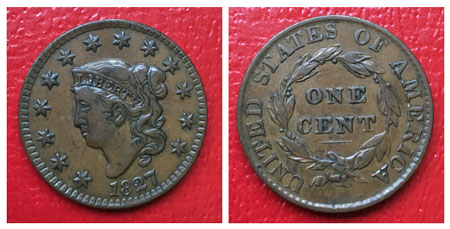
The US Mint's Philadelphia location produced over 2.35 million of these large cent coins.
Per the ANA Grading Guide, choice is "an adjective used to describe a select specimen of a given grade, designated as AU-55, EF-45, or VF-35."
In looking at the details on this coin, it certainly appears to be the Choice AU-55 (About Uncirculated).
The details on both the obverse and reverse are still clear with only small amounts of wear.
Per the ANA Grading Guide, choice is "an adjective used to describe a select specimen of a given grade, designated as AU-55, EF-45, or VF-35."
In looking at the details on this coin, it certainly appears to be the Choice AU-55 (About Uncirculated).
The details on both the obverse and reverse are still clear with only small amounts of wear.
Per the ANA, on the obverse, the hair above the eye shows wear; on the reverse, leaves above the O in ONE and the bow show trace of wear; while the surface of the coin still shows significant mint luster.
In other words, this is a very nice example of an 1827 Large Cent coin.
In other words, this is a very nice example of an 1827 Large Cent coin.
This collectible comes from Larry Jackson Numismatics, 404-256-3667.
It's a sealed bag of 1973 Lincoln Cents produced at the Philadelphia Mint location.
Still sealed, these coins would be uncirculated and part of over 3.7 billion Lincoln cents struck by the Philadelphia location.
Unlike today's coins, these weigh 3.11 grams and contain 95% copper and 5% zinc.
It's a sealed bag of 1973 Lincoln Cents produced at the Philadelphia Mint location.
Still sealed, these coins would be uncirculated and part of over 3.7 billion Lincoln cents struck by the Philadelphia location.
Unlike today's coins, these weigh 3.11 grams and contain 95% copper and 5% zinc.

The modern Lincoln cent weighs 2.5 grams and is mostly zinc (97.5%) and covered in copper (2.5%).
The increase in copper prices forced the US Mint to change the composition of the Lincoln cents.
As bullion, this bag would be worth more as copper. Unfortunately, it is still illegal to melt copper cents.
This bag, though, could be an interesting investment as either uncirculated coins or as bullion copper. At some point, Congress could change the law.
The increase in copper prices forced the US Mint to change the composition of the Lincoln cents.
As bullion, this bag would be worth more as copper. Unfortunately, it is still illegal to melt copper cents.
This bag, though, could be an interesting investment as either uncirculated coins or as bullion copper. At some point, Congress could change the law.
Buffalo or Indian Head Five Cent Coins
The US Mint's Denver location struck the first in this set of examples, the 1936-D.
The Mint produced over158.7 million of the coins at Philadelphia, Denver and San Francisco in 1936.
The Denver location also produced an unknown quantity of "3 1/2 legs" in their 24.8 million nickel coins.
This example is a nice specimen but of "average" quality. It's a good starter coin for a young collector.
The Mint produced over158.7 million of the coins at Philadelphia, Denver and San Francisco in 1936.
The Denver location also produced an unknown quantity of "3 1/2 legs" in their 24.8 million nickel coins.
This example is a nice specimen but of "average" quality. It's a good starter coin for a young collector.
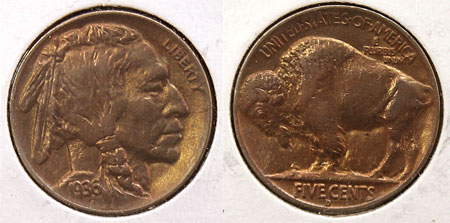
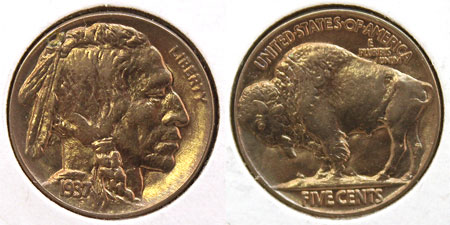
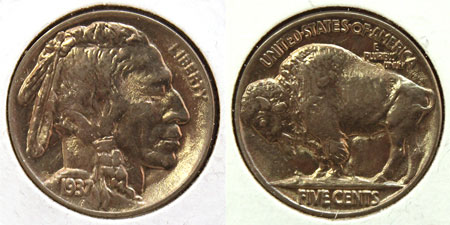
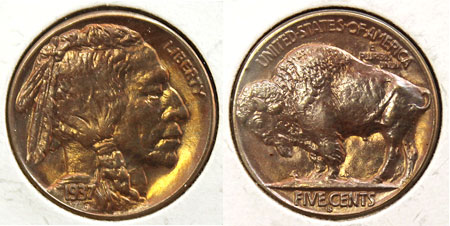

This next series of coins are nice examples of the American Buffalo Five Cent Coins.
The US Mint began producing the Buffalo nickel coins in 1913 and ended that design in 1938.
James Earle Fraser, a well-known mint designer, built his plan for the coin using three different Native Americans and the bison, Black Diamond, at New York's Central Park Zoo.
The US Mint began producing the Buffalo nickel coins in 1913 and ended that design in 1938.
James Earle Fraser, a well-known mint designer, built his plan for the coin using three different Native Americans and the bison, Black Diamond, at New York's Central Park Zoo.
This particular 1938-D has very few marks and the obverse has some mint luster but not as much as the 1937-S above.
On the reverse, though, the luster around the buffalo has pretty toning, stronger than the one above.
Of course, this is a nice specimen from the last year of Fraser's iconic design.
On the reverse, though, the luster around the buffalo has pretty toning, stronger than the one above.
Of course, this is a nice specimen from the last year of Fraser's iconic design.
The Philadelphia mint produced the next two Buffalo nickel coins in 1937.
Both of these are part of over 79 million five-cent coins struck by the Philadelphia mint that year.
The original mint luster still shows on both of these coins.
If you look closely on the obverse, you can see die polish marks on the left between the neck and the feather on one of the 1937 five cent coins.
Though, the numismatic glossary calls these die striations, but many numismatists prefer to call it die polish since the striations are raised lines that were struck with polished dies.
These striations become fainter as more coins are struck with the dies. This Buffalo nickel only has a few of the die polish lines, perhaps the die is toward the end of its usefulness.
Regardless, both of these 1937 five cent coins are nice examples to be added to a Buffalo Nickel collection.
The original mint luster still shows on both of these coins.
If you look closely on the obverse, you can see die polish marks on the left between the neck and the feather on one of the 1937 five cent coins.
Though, the numismatic glossary calls these die striations, but many numismatists prefer to call it die polish since the striations are raised lines that were struck with polished dies.
These striations become fainter as more coins are struck with the dies. This Buffalo nickel only has a few of the die polish lines, perhaps the die is toward the end of its usefulness.
Regardless, both of these 1937 five cent coins are nice examples to be added to a Buffalo Nickel collection.
Which grade could it be?
The coin has virtually no wear on the buffalo's rump or shoulder - the high points for grading purposes.
Plus, all the small details in the hair, feather and face are clearly visible on the obverse.
Perhaps a magnifying scope would see things a loupe doesn't, but this coin appears to be almost flawless.
The coin has virtually no wear on the buffalo's rump or shoulder - the high points for grading purposes.
Plus, all the small details in the hair, feather and face are clearly visible on the obverse.
Perhaps a magnifying scope would see things a loupe doesn't, but this coin appears to be almost flawless.
Continuing, the San Francisco mint struck the next five cent coin as one of the over 5.6 million they produced in 1937.
This Buffalo Nickel is a beautiful specimen with full mint luster and virtually no distracting marks.
Per the ANA Grading Guide that places this coin within the Mint State grades.
This Buffalo Nickel is a beautiful specimen with full mint luster and virtually no distracting marks.
Per the ANA Grading Guide that places this coin within the Mint State grades.
And, for those who like toning, the coin's luster has an orange cast, not really true toning, per se, but pretty, nonetheless.
Next and last in our Buffalo Nickel coins is a 1938-D, the last year the US Mint used this design.
The Denver Mint struck just over 7 million of the Buffalo five cent pieces before changing the dies to the new Jefferson nickel design.
Next and last in our Buffalo Nickel coins is a 1938-D, the last year the US Mint used this design.
The Denver Mint struck just over 7 million of the Buffalo five cent pieces before changing the dies to the new Jefferson nickel design.
For fun, this image from a 1966 Welcome to Coin Collecting small booklet shows the terms describing the different elements of a Buffalo Five Cent Coin.
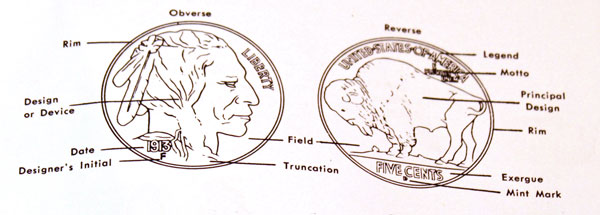
In total, the US Mint produced just under 29 million of the Jefferson nickels in its debut year with San Francisco striking the smallest number at just over 4 million.
This circulated coin, though a good example of the first year's production, has wear along the high points of Jefferson's cheek and Monticello's dome.
It still showcases Felix Schlag's design and would be a nice addition to a starter set of Jefferson Five Cent Coins.
This circulated coin, though a good example of the first year's production, has wear along the high points of Jefferson's cheek and Monticello's dome.
It still showcases Felix Schlag's design and would be a nice addition to a starter set of Jefferson Five Cent Coins.
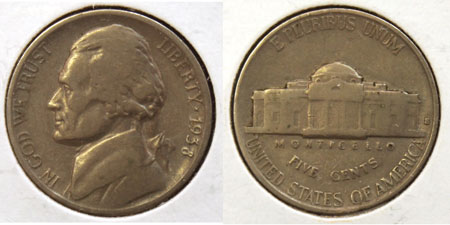
Another nickel, the San Francisco Mint struck this Jefferson nickel in 1938, the first year of that design.
Booker T. Washington Commemorative Coin
The San Francisco mint struck this first coin, a 1946-S, which is one of just over 500,000 they delivered in the first year of the design.
A non-numismatist might look at this coin and think it is damaged, however look at the grade.
NGC (Numismatic Guaranty Corporation) certified this coin as a MS-66, almost the top grade for mint state coins.
The obverse has toning while the reverse has spectacular luster.
A non-numismatist might look at this coin and think it is damaged, however look at the grade.
NGC (Numismatic Guaranty Corporation) certified this coin as a MS-66, almost the top grade for mint state coins.
The obverse has toning while the reverse has spectacular luster.
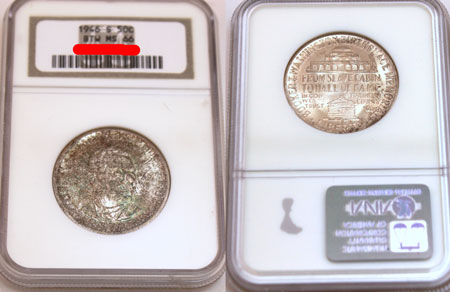

The next two examples showcase the Booker T. Washington Commemorative Silver Half Dollar Coin, one of the last designs in the classic commemorative series.
The US Mint produced this particular design in the years 1946 through 1951 at their Philadelphia, Denver and San Francisco locations.
The US Mint produced this particular design in the years 1946 through 1951 at their Philadelphia, Denver and San Francisco locations.
The Philadelphia mint struck this second Booker T. Washington commemorative coin in 1951, the last year of the design.
In total, the US Mint produced less than 225,000 of these coins in 1951 with the Philadelphia mint striking the majority at just over 210,000.
Look at this coin, NGC graded it as MS-65, again a high grade.
The obverse has excellent detail, however it is heavily toned.
The reverse, too, has all the design details and even prettier toning.
Some people like toned coins, some don't.
Look at this coin, NGC graded it as MS-65, again a high grade.
The obverse has excellent detail, however it is heavily toned.
The reverse, too, has all the design details and even prettier toning.
Some people like toned coins, some don't.
These two coins are excellent examples of high grades with significant toning.
Carver/Washington Commemorative Coin
The Philadelphia Mint produced this first example in 1952 as one of over 1.1 million struck at that location, the largest production number of any mint location for any year of the design.
This 1952 silver commemorative has dark toning, almost purple on the obverse with similar, but more consistent, toning on the reverse.
NGC certified this coin as MS-65, another high grade even though the coin is darkly toned.
This 1952 silver commemorative has dark toning, almost purple on the obverse with similar, but more consistent, toning on the reverse.
NGC certified this coin as MS-65, another high grade even though the coin is darkly toned.
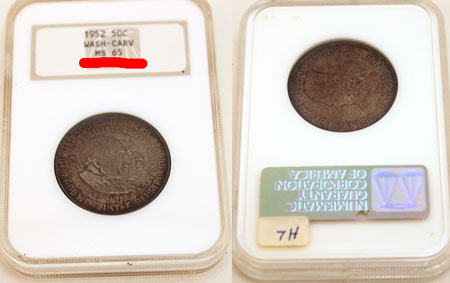
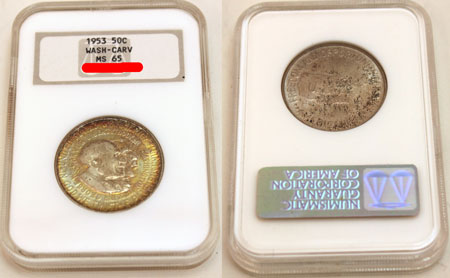
Similarly, the next two Carver/Washington Commemorative Silver Half Dollar Coins show highly graded coins with toning.
The last of the classic commemoratives, the US Mint produced the Carver/Washington silver half dollar coins in 1951 through 1954.
The obverse showcases busts of George Washington Carver and Booker T. Washington, while the reverse shows a map of the United States (only 48 states then) with U. S. A. across the states.
Philadelphia, Denver and San Francisco struck the coins in all four years.
The last of the classic commemoratives, the US Mint produced the Carver/Washington silver half dollar coins in 1951 through 1954.
The obverse showcases busts of George Washington Carver and Booker T. Washington, while the reverse shows a map of the United States (only 48 states then) with U. S. A. across the states.
Philadelphia, Denver and San Francisco struck the coins in all four years.
The Philadelphia Mint also produced this second example from 1953 as one of just over 8000 struck at their location that year.
This coin, graded as MS-65, has golden toning around the obverse along with significant mint luster.
The reverse, too, has luster but only minor toning.
These two coins highlight the end of the classic commemorative coin era that began with the Columbian Exposition coins in 1892 and ended with the Carver/Washington design in 1954.
This coin, graded as MS-65, has golden toning around the obverse along with significant mint luster.
The reverse, too, has luster but only minor toning.
These two coins highlight the end of the classic commemorative coin era that began with the Columbian Exposition coins in 1892 and ended with the Carver/Washington design in 1954.
McKinley Commemorative Gold Coin

They struck 15,000 in 1916 and 5,000 in 1917.
This specimen came from the first year of production.
Charles E. Barber designed the obverse with a left-facing portrait of the president.
On the reverse, George T. Morgan, of Morgan Dollar fame, designed an image of the memorial building that would remember the president.
This specimen came from the first year of production.
Charles E. Barber designed the obverse with a left-facing portrait of the president.
On the reverse, George T. Morgan, of Morgan Dollar fame, designed an image of the memorial building that would remember the president.
However, not all of the classic commemoratives were silver or half dollars, only the majority were.
The US Mint produced the McKinley Commemorative Gold Dollar Coin in 1916 and 1917 at their Philadelphia location to help pay for the memorial at his birthplace in Ohio.
The US Mint produced the McKinley Commemorative Gold Dollar Coin in 1916 and 1917 at their Philadelphia location to help pay for the memorial at his birthplace in Ohio.
The US Mint produced very few gold designs for the classic commemoratives, most during the early years.
This gold dollar, smaller than today's dime, showcases the Mint's artistic capabilities in miniature.
This gold dollar, smaller than today's dime, showcases the Mint's artistic capabilities in miniature.
Dahlonega Branch Mint 150th Anniversary
This envelope with its image of the original mint building has a pictorial cancellation honoring the 150th anniversary with an image of the mint's building.
The top of the cancellation reads 1838 U. S. Branch Mint 1861; The Mint Station.
Underneath the postal mint building is 150th Anniversary 1838 - 1988.
Of course the Feb. 12, 1988 postal date commemorates the Dahlonega Mint's first day of operation, just 150 years later.
The top of the cancellation reads 1838 U. S. Branch Mint 1861; The Mint Station.
Underneath the postal mint building is 150th Anniversary 1838 - 1988.
Of course the Feb. 12, 1988 postal date commemorates the Dahlonega Mint's first day of operation, just 150 years later.
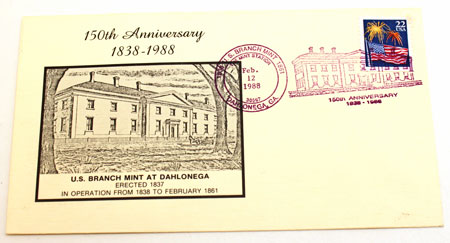
Of course, one of the US Mint's locations, just a few miles north of here, produced just gold coins from 1838 to 1861.
The Dahlonega Mint facility was built in 1837 and operations began on February 12, 1838.
The Dahlonega Mint facility was built in 1837 and operations began on February 12, 1838.
The envelope provides an interesting bit of history with its image of the mint building alongside a postal cancellation also showing the old building.
US Mint Souvenir ANA Sets

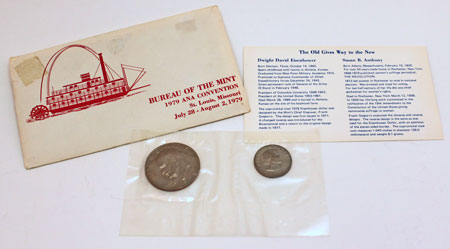

On occasion, the US Mint provides special souvenir sets at numismatic-related events.
These three souvenir sets remember three ANA (American Numismatic Association) events, one each from 1978, 1979 and 1980.
The Mint developed this first example in 1978 for the Houston, Texas ANA Convention.
These three souvenir sets remember three ANA (American Numismatic Association) events, one each from 1978, 1979 and 1980.
The Mint developed this first example in 1978 for the Houston, Texas ANA Convention.
The set contains a 1978 Eisenhower dollar coin from the Denver mint along with a bronze medal of Lyndon B. Johnson.
The enclosed description is titled "Our Two Texas-Born Presidents."
Though he spent much of his youth in Abilene, Kansas, President Eisenhower was born in Denison, Texas on October 14, 1890.
Eighteen years later, President Johnson joined the world on August 27, 1908, on a farm near Stonewall, Texas.
The enclosed description is titled "Our Two Texas-Born Presidents."
Though he spent much of his youth in Abilene, Kansas, President Eisenhower was born in Denison, Texas on October 14, 1890.
Eighteen years later, President Johnson joined the world on August 27, 1908, on a farm near Stonewall, Texas.
The US Mint produced the Eisenhower dollar during 1971 through 1978.
They also produced the bronze medal of Johnson as part of the official Presidential Miniature Series.
The US Mint sold this souvenir set during the 1978 Houston ANA Convention.
The Mint produced another souvenir set for the St. Louis, Missouri ANA Convention held July 28 - August 2, 1979.
They also produced the bronze medal of Johnson as part of the official Presidential Miniature Series.
The US Mint sold this souvenir set during the 1978 Houston ANA Convention.
The Mint produced another souvenir set for the St. Louis, Missouri ANA Convention held July 28 - August 2, 1979.
This set contains two dollar coins, a 1978 Eisenhower and a 1979 Susan B. Anthony, both from the Philadelphia mint.
The enclosed description titled, "The Old Gives Way to the New," provides historical comments of the lives of President Eisenhower and Suffragette Anthony.
Frank Gasparro designed both of the coins, and the production of both of the coins spanned a limited number of years.
The enclosed description titled, "The Old Gives Way to the New," provides historical comments of the lives of President Eisenhower and Suffragette Anthony.
Frank Gasparro designed both of the coins, and the production of both of the coins spanned a limited number of years.
The Eisenhower dollar from 1971 through 1978 was large and heavy making it unpopular as pocket change.
The Susan B. Anthony dollar produced in 1979 through 1981 and 1999 was small but too much like a quarter dollar to gain any popularity.
The Susan B. Anthony dollar produced in 1979 through 1981 and 1999 was small but too much like a quarter dollar to gain any popularity.
For the 1980 ANA Mid-year Convention in Albuquerque, New Mexico, February 15-17, the US Mint produced a souvenir set containing a Susan B. Anthony dollar coin and a bronze medal.
The face of the souvenir envelope also recognized the Director of the Mint, Stella B. Hackel.
The Mint's San Francisco location produced this Susan B. Anthony dollar coin and the bronze medal in the set.
The bronze medal shows The Department of the Treasury 1789 around the design of the Treasury emblem.
The opposite side depicts the United States Assay Office San Francisco California and an image of the mint building with an "S" mint mark beneath the design.
The face of the souvenir envelope also recognized the Director of the Mint, Stella B. Hackel.
The Mint's San Francisco location produced this Susan B. Anthony dollar coin and the bronze medal in the set.
The bronze medal shows The Department of the Treasury 1789 around the design of the Treasury emblem.
The opposite side depicts the United States Assay Office San Francisco California and an image of the mint building with an "S" mint mark beneath the design.
Perhaps by selling this souvenir set at the ANA Convention, the US Mint wanted to continue promoting the unpopular Susan B. Anthony dollar coin.
That concludes this odd but interesting set of collectibles that could have been seen at the April 2020 coin show had it occurred.
That concludes this odd but interesting set of collectibles that could have been seen at the April 2020 coin show had it occurred.
